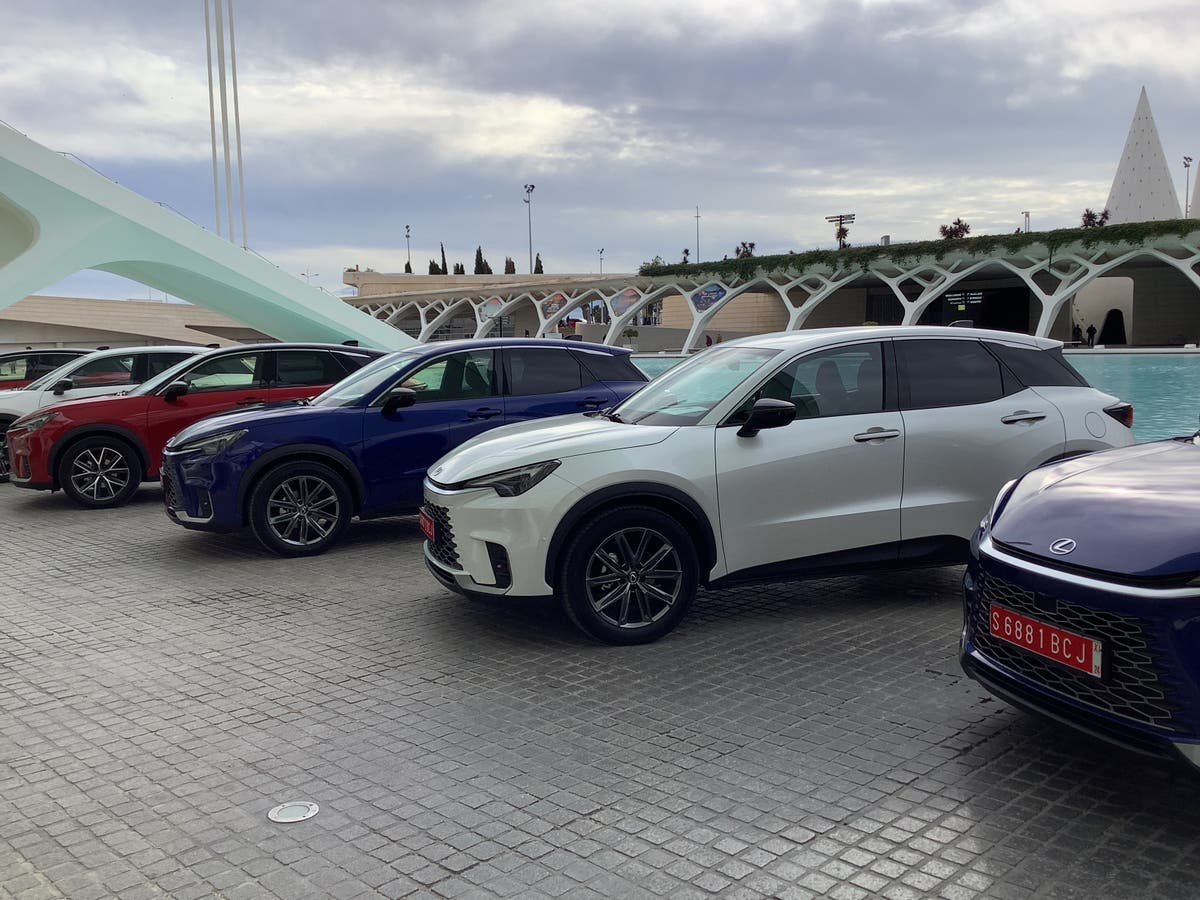So, what is the Lexus LBX? Fortunately, you’ll always be able to remember one version of its identity at least because the name LBX is a handy mnemonic, or near-mnemonic – “Lexus Breakthrough X-over” (ie SUV/hatch crossover). It’s thus the smallest, cheapest vehicle to wear a Lexus badge, and the first to feature a three-cylinder engine.
It shares much of its engineering with the Toyota Yaris (Lexus being the company’s upmarket brand), and it’s a petrol hybrid – of course, because Toyota don’t really buy into the EV revolution. (There will be no all-electric battery powered LBX, in case you were wondering).
The LBX looks especially good with ‘Elegant Blue’ paintwork and exquisitely stitched tan seats
(Sean O’Grady)
You can get a version that mimics four-wheel drive, but basically this is your standard sort of compact SUV, with an electric motor at the back, but it seems pretty futile.
This is urban transport that can hold its own over long distances too, and with a genuinely luxurious/premium feel to it. It’s a fine package: The Audi Q2, Mercedes-GLA and Mini Countryman are its posh rivals.
The stylists have obviously spent a great deal of effort on getting all the detailing right
(Sean O’Grady)
It’s a lovely car, in fact, and somehow, within the usual conventions of these types of cars, of which there are now a great number, they’ve imbued it with some personality and distinctiveness of its own.
I like the youthful chubby proportions combined with some mature abilities (for some reason it reminds me of Luke “The Luke” Littler), and the stylists have obviously spent a great deal of effort on getting all the detailing right. Hence, the precisely cut honeycomb grille with no surround that merges into the bumper; and the generally flawless fit and finish – lining up to the best traditions of Toyota group build.
The precisely cut honeycomb grille with no surround merges flawlessly into the bumper
(Sean O’Grady)
In choice of construction materials, a slightly longer wheelbase, and a more expensive kind of bipolar battery, the Lexus designers have built “premium” features into the car that go well behind the usual cosmetic upgrades.
There’s quite a range of trim-levels and colour options, and, for what it’s worth, it looks especially good with “Elegant Blue” paintwork and exquisitely stitched tan seats.
For safety’s sake the LBX is kitted with all the latest autonomous driving features, plus an “e-latch” that tries to prevent you opening the door if the car senses a vehicle or bike coming up on the side – an excellent idea.
The Lexus LXB has to be the most cosseting car around for its size
(Sean O’Grady)
Audible speed limit warnings are also now fitted on all new cars, which some folk will find irksome and nannying but might well save you from a speeding ticket, or worse.
The doors, by the way, feature the trendy idea of an electric button release rather than a traditional handle (though there is one concealed in the door pocket in case of failure). Another novelty is that you can forget about the car key – in a good way.
An ‘e-latch’ will prevent you from opening the door if the car senses approaching cars or bikes
(Sean O’Grady)
Lexus say that the LXB can “be opened and started using a new smartphone app-based digital key. You don’t even have to take your phone out of your pocket or bag – just having it on your person gives you access. The app can be shared with up to five users and it’s compatible with both Apple and Android devices.”
I didn’t have the chance to test this, so you’ll have to take that claim at face value. I can foresee problems with it…
With Lexus you get quality, reliability and an enviable reputation for excellent customer service
(Sean O’Grady)
But none of that is really the point of the LXB, which is to be the most cosseting car around for its size (given that smaller vehicles are always going to be inherently more “choppy”).
The synthetic leather seats, for example, are especially sumptuous, and then there is the “Hey Lexus” voice recognition software (OK for the basics). As a “self-charging” hybrid (ie a petrol car with regenerative braking that can deliver short bursts of electric-only propulsion) if you drive it gently enough around town you can travel in silence.
THE SPEC
Lexus LBX Premium Plus
Price: £34,495 (as tested; range starts at £29,995)
Engine capacity: 1.5l petrol, 3-cyl, 1-sp auto + elec motor
Power output (bhp): 134
Top speed (mph): 106
0 to 60 (seconds): 9.2
Fuel economy (mpg): 59
CO2 emissions (WLTP, g/km): 108
On the other hand, as with every hybrid, if you find yourself having to put your foot down on the motorway or up a hill, you’ll find the traditional hybrid “whine” – where increasing the engine revs via the continuously variable transmission generates more noise than acceleration. It’s fairly minimal though, and usually the three-cylinder engine emits a nice quiet thrum.
I noted that if you use your phone and Google maps to navigate then you don’t get the relevant instructions to show up on the virtual “head up” display, and that the screen map disappears when you’re at a junction –the display switches to camera mode (for safety), but these are minor niggles, to be fair.
Dynamically, it’s quite satisfactory and class-competitive, though the steering feels a bit remote. I guess it’s more worth mentioning that you obviously get Toyota levels of quality and reliability thrown in, and that Lexus dealers have long enjoyed an enviable reputation for excellent customer service.
You can open the boot and even start the car using a new smartphone app-based digital key
(Sean O’Grady)
But the lovable little LXB comes with a snag – a premium price tag, starting at about £30,000 and topping out nearer to £50,000 if you go a bit mad with the options – so you will need to be well-padded financially if selecting that.
Something for The Luke to spend his darts winnings on, then.








